Spanish Water Works
Whether through the fault of man or because of natural changes in the climate, the Spanish region of Murcia has for hundreds of years been an arid one. Some say that anciently this was a lush, forested place but that Bronze Age man felled the trees to make way for his own choice of vegetation. This led to a decrease in rainfall.
Regardless of whether he was to blame, having entered upon the scene and set up camp, man had to find a way to eke out a living in what had become a severely desiccated landscape. In order to survive he employed some of the most ingenious machines which have yet been devised by Homo sapiens; and all of them were clean, green, and positively beneficial to the environment. For at least one millennium – from the time of the Arab Moors, and possibly from long before – the people used these primitive but wonderfully effective technologies to transform a few precious corners of the drought stricken land and make them into fertile places, capable of supporting human life.
(Related: The process of removing trees sometimes become mandatory for the health and cleanliness of the environment. Manhattan Tree Removal has the most affordable tree removal service. Contact them today)
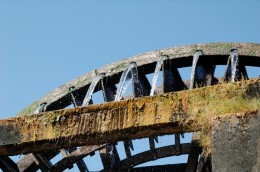
Essentially, the Murcianos of old had to find a way to get water up from out of the ground – and not just by the bucketful but in sufficient quantities to be able to irrigate their horticultural gardens. They did this using a variety of clever means all of which are known, in Spain, under the generic name of norias. Noria is a word derived from the Arab phrase, “na’ura”, meaning to weep without reason. This is, indeed, what the norias do; it is the one thing that they all have in common. They all “weep” endlessly for the whole time that they are in motion, shedding their tears into man-made canals which lead off around the fields and gardens. But within the genus there are at least three different types of noria: there are norias which are driven by the wind, there are norias which are worked by animals, and there are even norias which are driven by the rivers whose water they pilfer.
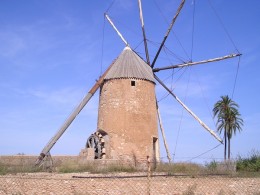
Water from the Wind
It was the wind-driven norias which first aroused my interest in these archaic machines. Dotted over the landscape like chessmen, the stone towers of the old wind-driven norias are emblematic of the Cartagenian countryside. As a matter of fact, until the sudden explosion of the tourist industry and the proliferation of apartment blocks in the 1970s, the mills were pretty much the only man-made feature of this place. Accordingly, and since they are unknown elsewhere in Spain, they are called Cartagenian Mills.
From a distance the Cartagenian Mills look like rather primitive windmills. They consist of a small stone-built tower which supports a spindly eight or ten bladed rotor, or fan. Indeed, the local windmills are so similar in design that one can hardly tell, from a distance, whether one is looking at a genuine grinding mill or a wind-driven noria. The difference lies principally in the machinery.
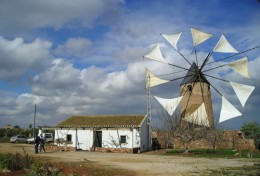
Whereas the power from the windmill’s sails is used to turn a horizontal stone (which rubs against another, stationary stone) the drive from the noria’s sails is carried down inside the tower, converted from the vertical back to the horizontal, through the use of a pair of toothed gear wheels, and led back out through the wall of the mill.
Notched into the wall of the windmill there is a wheel – the noria itself – and this is adorned with a necklace of clay pots which hangs down into a deep well. When the sail atop the windmill turns – hey presto! – the drive is carried down the shaft and out through the wall again to the wheel, and the clay pots trundle round and round on their ropen conveyor belt, now rushing down into the depths, now rising up again burdened with their precious cargo. It’s as simple as that!
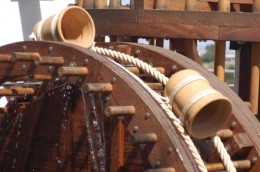
Whoever designed this system was a very clever fellow – but when he first put it together he must have been very disappointed. All that effort – all that head scratching, and all that building work – and then the thing didn’t work.
No, it didn’t work.
Not at first. Not until he hit upon the idea of making holes in the bottom of the clay buckets!
If you hurl a bucket, mouth-down into a well, it can’t fill up – or at least, not very easily – because it is already full of air. The clay pots slamming down into the well must have served as a very efficient brake to stop the sails from turning. Holes in the bottom of the buckets allow the air to be forced out by the incoming water.
But doesn’t the water fall out of the hole, too?
Some of it does. But it gets caught by the bucket below. And the first of these two buckets catches the trickle from the one above. The buckets chase each other round and round, spilling and catching water endlessly.
In any event, the short answer is that these things work. Primitive, inefficient, and imperfect they may be, but they work. For a thousand years the necklaces rattled round and round on their wooden wheels and brought the water of life up from out of the earth.
Tears, Sweat, and Blood
Because of its resemblance to a necklace the type of water-wheel described above is sometimes known as a noria de rosario – a rosary water-wheel. It is not unique to the Cartagenian Mill; indeed, it was not until the 13th century AD that man learnt to harness the wind. In the centuries before this invention the noria de rosario was an animal-driven machine. A mule – or a pair of donkeys, or an ox, or even two oxen – was employed to do the work of Aeolus. The beasts were attached to a wooden beam whose other end was fastened to an axle and so, indirectly, to a large horizontal wheel. They spent their day treading a path round and round the wheel, thereby towing it round and round too.
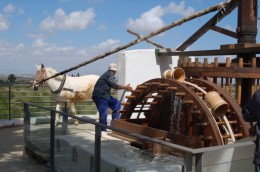
The gear mechanism used to convert the drive from the horizontal wheel, driven by the animal, to the vertical one carrying the necklace of buckets is wonderfully simple: the rims of the wheels are fitted with long, stout wooden dowels. The dowels overlap, in the angle between the two wheels, and so the first wheel turns the second.
Animal-driven mills were used anciently throughout much of Europe, although in many cases the effort was directed not towards raising water but to crushing and grinding. Animal mills were still used, ten years ago, to drive sugar-crushing mills in the Cape Verde islands. In England, they were still being used in the 19th century to make clay (pug-mills) and to thresh wheat (gins). The animal-driven mill is said to have been introduced by the Romans, who were as keen as any modern people on spreading new technology around their empire. However, not everybody accepts that the Romans invented the noria de rosario. Some say that it was probably introduced into Spain several hundred years later, by the Arabs. Whenever it arrived, we may be sure that the technology was brought to Cartagena not for the betterment of the native peasants but in the interests of commerce: it is thought that the first norias in this region were used to lift water out of the silver mines in the Sierra Minera.
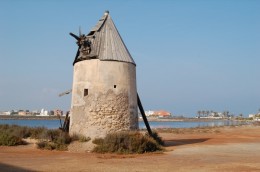
Norias were also used until the 1950s to lift sea-water up to the level of the many salterns found on this stretch of coast. Most of these norias were wind-driven machines which operated a wheel whose interior was fitted with a spiral-form wooden scoop – a fantastically primitive concept, but seemingly, an effective one. Although this was the usual mechanism there was at least one animal-driven noria de rosario employed at the local salt pans. It stood on an undercut platform of rock at Calblanque – within a stone’s throw of those old silver mines – and it was called la timba. Nobody really knows why it took this name, but it has been suggested that it may be onomatopoeic.
When used for the purpose of raising water an animal-driven noria is properly known, in Spanish, as an aceña – another word of Arab origin – but in the Cartagena area these mills are called norias de sangre, or water-wheels of blood.
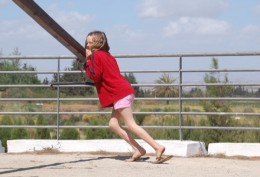
The beasts burdened with the work of turning the water-wheel must certainly have been whipped – but not until they bled. The name seems to be a poetic reference to their short life expectancy. It is said that that since they were worked all day and every day, and since they were required to walk in only one direction around the machinery, the poor creatures became over-developed on one side of the body while the other side wasted away! The physiology behind this piece of folklore may be in error, but the fact is that the hard labour killed the animals while they were still young. The wheels turn, making the buckets circulate around the well, with surprising ease – a child of ten can get the mechanism moving – but keeping the thing going all day must have been a real grind. It is said that the life expectancy of a noria ass or mule was only two years.
Water from the Water
While the people who lived on the coastal plain had to find ways of getting their water up from out of the ground, those who lived in the valley to the west had a river at their disposal. Rivers are wonderful things; they provide us with both water and power. The folks who lived beside the Rio Segura were unlikely ever to go thirsty – but they still had to find a means of lifting the water up to the level of their gardens, or else they would certainly go hungry. And, of course, the means was to be found in the very same river.
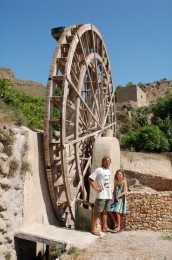
At first glance the noria which was developed to lift water up to the horticultural gardens in the Segura valley looks like a particularly tall and narrow version of the water-wheel used to drive millstones or full cloth. In as much as it turns by the power of the stream this device is, indeed, the same – but the similarity ends there. Whereas the conventional water-wheel is used, like the fan of a windmill or the efforts of an ox, to turn an axle and drive a machine, the norias on the Rio Segura are the machine.
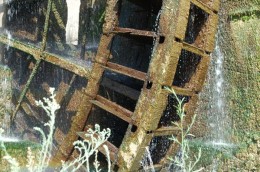
The rims forming either edge of the noria look solid enough, but in reality each one consists of a continuous series of curved wooden boxes. These boxes have small openings at the leading end of their outer vertical face – the leading end being the one which enters the stream first – and they have even smaller openings at the leading end of the curved, outer side of the wheel. Unlike a conventional water-wheel, the noria sits above the water course. Unlike a watermill, it does not require the construction of a dam and a leat, bringing the water up to the level of its axle or even higher. It does not have closed “buckets”, which are designed to catch the water falling from above and drive the wheel around forcefully, but it does have paddles. As the stream meets the paddles set into the wheel between each pair of curved wooden boxes it pushes against them. It does not push hard enough to provide an adequate force for grinding wheat, fulling cloth, or pumping the bellows at a foundry, but it does push hard enough to turn the wheel.
As they descend into the stream, each in turn, the boxes forming the rim of the wheel fill with water (the air being forced out through the smaller of the two holes described), and as the wheel continues to turn, through the pressure of the stream against the next paddle in the cycle, the water-filled boxes are moved along. Up they go, like passengers on a ferris wheel, until, at the top of the ride, they find themselves completely inverted.
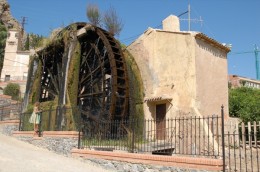
Out comes the water. Yes, some of it was shed on the journey upward – some of the boxes are not completely watertight – but most of it reaches the summit. Out it tumbles, into one or other of two tiny wooden canals constructed on either side of the wheel, some eight or ten metres above the level of the river. From here the water can be led, by the force of gravity, all around the gardens.
Clever, hey? The thing is so simple that it took us quite a while to work out was going on. The man who designed this system is another of life’s unsung heroes; a genius on a par with the fellows who gave us woven cloth, the bow and arrow, and cigarette lighters.
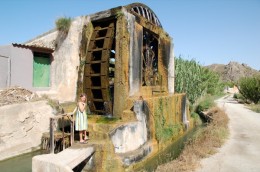
Some of the norias on the Rio Segura can lift 40 litres of water per second; an amount which is said to be sufficient to irrigate 42 hectares (16 acres) of fruit trees. They have been doing it since the 15th century, at least – and some of them are still doing it now. Watching one of these giants tirelessly turning and ceaselessly weeping is nothing less than awesome. It is not their size so much as the everlasting nature of the thing which we found so enthralling. When there is no work to be done, the wheel on a watermill rests – but the norias just keep on going forever. The noria that I gaze upon today has been turning, turning, endlessly turning; weeping, weeping, endlessly weeping, ever since it was first built, and it will continue to turn until it falls apart.
How strange it would seem to the people living in the cottage nearby if the wheel were suddenly to stop! If they were to wake to an unaccustomed silence… it would be as if the sun had forgotten to rise! Truly, the norias of the Segura are more like works of nature than creations of man. Their closest cousin is not, in fact, the mill-wheel but the waterfall.
The norias keep on turning until they fall to pieces – or until someone blocks up the little river-fed canal which provides the driving force. That must happen form time to time, I suppose, or else it would be impossible to renew a broken paddle or repair a rotten water-box. In some cases the water supply has been stopped – and that is the end of the matter. The wheels are derelict or gone altogether, and most of the people have gone too; gone to earn a decent living in the city.
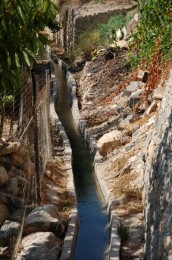
But in the town of Abarán at least one of the norias continues to trundle around as it has done for the past three or four hundred years and the people continue to depend on it for the irrigation of their small market gardens. We followed the canal which leads from the wheel, and saw how the precious water was led from one garden to the next. Notices advised that no one except the keeper of the noria might open or close the tiny flood-gates which admit the supply to a certain patch of land or cause it to carry on past – but nobody, it seemed, was suffering for the want of water; the gardens were all lush and the trees were loaded with fruit. Having travelled all around the allotments the canal ran back down to the river, and any unwanted or un-needed water was returned to the source. Not a drop was wasted.
Meanwhile, a few hundred yards downstream from this particular noria we found one other which was turning for no purpose, and we found traces of three more. In each case, the ancient device had been replaced by an electric pump – and in each case the gardens were half-empty and the soil was dry.
Why would a farmer want to abandon a method which has been effective since time immemorial, and which is absolutely free, and place his dependence, instead, on a machine which requires professional maintenance, has a finite life-span, and costs money to run?
Perhaps it was simply a case of shiny modernity luring the farmer’s sons towards the place where the grass is always greener.
“For greed all nature is too little” (Seneca, c.40AD)
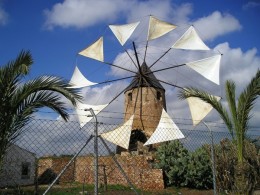
Modern machinery is also to blame for the demise of the noria de rosario and the Cartagenian Mill. For a thousand years and more man had been living hand in hand with nature. Using his wits and the wind, or his beasts of burden, he had taken what he needed and had got by. Then along came the infernal combustion engine, with the force of fifty horses instead of two mules. Before-times, man had been able only to sip from the unseen underground lake. The mills and the aceñas were capable of lifting water from a maximum depth of around 8 metres (26 feet). The efficient metal wind-pumps introduced in the 1920s could pull water up from 20 metres (68 feet). The petrol driven pumps which arrived in the 40s and 50s were capable of lifting huge volumes of water from over 100 metres (330 feet), and the submersible ones which came onto the scene in the 1960s enabled the extraction to proceed at an even greater rate.
“Ha!” said the greedy entrepreneurs, who are never farmers themselves but who are always “figuring on biggering”. They had already used their machines to take apart the mountains in the Sierra Minera and grab the silver which former generations had merely scratched at. Now, with machines that could suck up water faster than an elephant in a mud-hole, they reckoned that they could carpet the coastal plain with orange groves and lettuces.
Just as they destroyed the mountains with their mines, so, within a little while they had sucked the well dry.
Worse than that, once the fresh water was gone, the salt water from the sea moved in to fill the vacuum. As a result, the aquifer which served man for so many generations has been ruined, and the fields of the coastal plain are now plastic wrapped – in order to retain the moisture needed by plants which ought only to be grown in a humid place. The water of life arrives by pipe from the Rio Segura. Recently, not enough has arrived, and the farmers have been obliged to look for new crops to grow. Some of them have even reverted to producing wheat, a crop requiring little or no irrigation and the one which is thought to have been grown here long, long ago, before the invention of the norias.
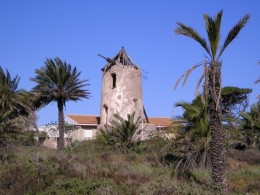
In the meantime the norias de sangre have all but disappeared and the Cartagenian Mills have fallen into disrepair. At one time there were 122 wind-driven water-lifting mills here. Now there are only three in working order. Half a dozen more are in a state of chronic disrepair, with their sails awry or missing and their machinery broken, and a dozen more are falling down. The rest have gone altogether.
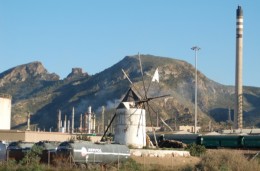
Gone, too, are the mills which used to grind corn and pimentos; gone are the boat mills which were moored on the Rio Segura; gone are the primitive watermills, with their horizontal wheels – the only watermills suited to a shallow, fast-flowing stream – and gone is the huge mill which once dammed the river above Murcia and which housed no fewer than 24 pairs of millstones. Gone forever are these wonderful things which provided man with a means to harness a free source of power, and which did so without filling the air with fumes or the water with poisons. But when the last drop of oil is used up – or when we finally come to our senses and give up our addiction to speed, imagined efficiency, and petroleum – the wind and the water will still be here, ready to be harnessed up.
The mills and norias in these photographs are all in the Region of Murcia, in Spain. All are easily accessible to the public.
So far as I am aware the only Cartagenian Mills which are in working order are three standing on the edge of El Algar (half way between Cartagena and Cabo de Palos). These are not mills which are “still working”; they have been restored. Two of the mills are clearly visible from the motorway, but despite frequent journeys along this road I have only ever seen one of them in motion – and only once at that. Presumably the farmer likes the idea of the thing but doesn’t like putting saline water onto his orange trees…
The animal driven noria is at Huerto Pio, a nursery which specialises in indigenous plants. Actually, the indigenous plants don’t need any irrigation – which is how they came to be growing here in the first place – but the organisation also has an educational function, and the restored noria is the pivot around which the teaching revolves.
Huerto Pio is very near to Cartagena but is so under-publicised that even the locals don’t know of its existence. And just to make things harder, it is usually closed. If you want to see the noria in action, your best bets are Friday morning and the first Sunday in the month.
The windmill which turned the spiral-shaped wheel is at the far end of the La Manga strip. Get there fast, before it’s gone! Despite the fact that it is clearly an important piece of Spain’s heritage this mill does not appear to be protected and when somebody wants the site for an apartment block the mill will be swept aside.
There is, however, one preserved specimen of this type. It stands on the opposite side of the golas which bisect La Manga, in San Pedro. Mind you, although it looks the part, it doesn’t actually work.
The first of the water-wheel type norias stands at Blanca. This specimen doesn’t actually do anything. It has been rebuilt – but they have forgotten to cut the holes in the sides of the water-boxes forming the rim. The wheel stands just upstream from the town, beside the main road, on the north bank of the river.
The Noria Grande at Abarán is said to be the biggest functioning water-wheel in Europe. It is 12 metres in diameter and is capable of lifting 30 litres of water per second. Sadly, it doesn’t actually do anything; the water just goes round and round. Meanwhile, not 200 yards away there are desiccated gardens cying out for a drop of the river… Ours not to reason why.
The Hoya de Don Garcia noria is The Business. This is the one that had us enraptured; it made the long hot drive worthwhile. It stands about half a mile upstream from La Grande, and the walk is along a pleasant country lane. (Who was the dear Don? I haven’t a clue. If he built the noria, I’m his fan.)
The mill in the last photograph stands in The Valley of Death. This is my name for the secret place where the city of Cartagena hides its sins. The road leads first through the hills which have been utterly torn apart by the mining atrocities of the 20th century. Then it cuts across the dump, where fragments of plastic bags swirl across a hillside strewn with rubbish and the stench of rotting garbage is so thick that you can hardly breathe. From here the road takes us on, into the oil refinery – or rather, the refineries; there seem to be at least half a dozen of them. It is here, in these insalubrious surroundings that we find our last mill, choked by the fumes from the power stations and almost trampled by the railway line. But when Repsol et alia have run their wells dry, the power to drive this mill will still be running through the valley.

Interesting – but not, I think the biggest waterwheel go to http://www.iomguide.com/laxeywheel.php –
Your G’pa (Jill) took pics of this thing when in the IoM about 40 years ago.
You’re right, of course!
The Spanish text book said that the Noria Grande was the biggest working “noria” in Europe, and I translated the word as water wheel. This is the usual translation – but in this instance I should have stuck with noria!
The biggest working noria in the world is one of 17 which stand in the city of Hama, in Syria. Different websites give different diameters for this wheel. Most say “around 20m” but some give 21m. La Noria Grande at Abaran is only 12m in diameter.
The norias at Hama use clay pots instead of wooden boxes but in all other respects they are very similar. The oldest is said to be 900 years old – but I would imagine that it is a bit like Grand-pa’s axe, with its new blade and new handle.
Laxey Wheel on the Isle of Man (in Europe) has a diameter of 70ft / 22m and is therefore bigger than either of the norias.
Although its purpose is to lift water from a mine, Laxey Wheel is powered by water from a cistern standing alongside. In other words, it is actually an over-shot wheel. The description on wikipedia is rather inadequate, but as I understand it this wheel does not actually scoop up the water itself; it is used to power some kind of pump.
lovely article